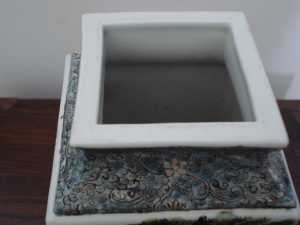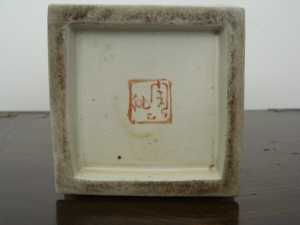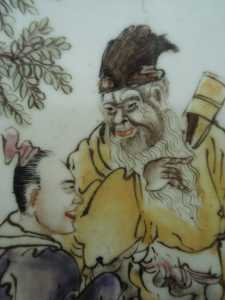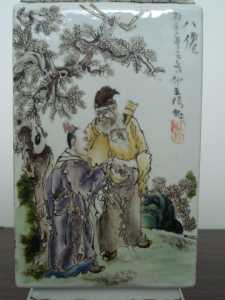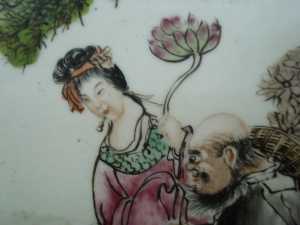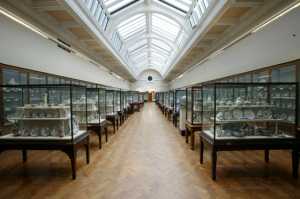The Chinese and Asian Art Forum. For Fans, Collectors and Dealers.
 Basic Rules For the BidAmount Asian Art Forum: Talk about whatever you want. You can even discuss and offer things that are for sale if they are authentic. Maximum image file size per post is 2 MB. Images of 700pxl x 700pxl are optimal if saved at a medium resolution. Be respectful of others and enjoy yourself. Click the YouTube link for a brief tutorial on using the forum. You can also EMBED Videos by cutting and pasting from You-Tube, Vimeo etc.
Basic Rules For the BidAmount Asian Art Forum: Talk about whatever you want. You can even discuss and offer things that are for sale if they are authentic. Maximum image file size per post is 2 MB. Images of 700pxl x 700pxl are optimal if saved at a medium resolution. Be respectful of others and enjoy yourself. Click the YouTube link for a brief tutorial on using the forum. You can also EMBED Videos by cutting and pasting from You-Tube, Vimeo etc.
NOTE: To post an item or add a new post, click open the category title from the FORUM LIST, and CLICK the Blue ADD TOPIC button.
Dear John,
Your following question: “For example, if you were to finish the following sentence what would you say: "A good Kangxi famile verte baluster vase should be/have __________” is denoting which is your approach in judging an art object, and it is just the wrong approach.
The correct answer to your question is: “A good Kangxi famille verte baluster vase should be painted by the hand of an artist of the period”.
Why do you not compare the decoration of that vase with that of a genuine one? The difference is abysmal. If you do not see the difference, then you do not have an educated eye. Exactly as myself have not an educated eye in judging carpets, for example.
Do not look for shortcuts, there are no shortcuts, you must have knowledge, that’s it.
Do not look at eBay, you learn nothing from there. Do look at, as suggested by William, at books, museums, auctions from the major auction houses.
Dear William, I do share each of your words. I do not answer to all the things posted here because some of them are really unwatchable. Luckily, there are members much more generous than myself.
Giovanni
@william I share your belief, and I would add that no matter where you live or how much resources you have access to, it takes time to develop the abilities to distinguish the subtle differences of quality and age in Chinese porcelains. Yes, a few years just to get your feet wet, and a lifetime to achieve enlightment.
To share a story, here are photos I took of a vase I bought when I was first learning about Chinese porcelains (about 10 years ago). In looking at my files, I see that I called it 'famille verte vase', and as you can see it is clearly a famille rose vase.
I recall at that time I had heard about the 8 friends of winter, the great porcelain masters of the Republic period, and in finding this vase, I was quite sure it was one of their works. Even as I compared the vase to known examples, I was blind to the differences in the quality of the rendering because of two reasons...
First, I could not differentiate intentional artistic effect from the shaky hand of a faker trying to copy a master because I had not seen enough genuine examples, or for that matter, enough copies....lack of experience.
Second, I was so emotionally invested in having found what I thought was a valuable treasure, I could not separate my bias from reality. I could not accept that what I thought was genuine was in fact a pretty awful copy because I had found it, and my pride was misplaced (common for both novices and experts).
We must humbly all accept how imperfect our own perceptions are due to human nature, but we can overcome that through discussion with others who can enlighten us with their objectivity, wisdom, and yes, sometimes harsh criticism.
You know, as an artist myself I fully understand that the whole is greater than the sum of its parts, so there is really no need to continue that lecture for my benefit. I spend hours per week looking at genuine examples in whatever way I am able, but my eye is only beginning to become atuned to certain aspects of quality. As many have noted, it takes years to develop. I of course will follow the advice of Bill, Giovanni, Greeno and others by looking to handle as many pieces of quality as I can over time and build up my knowledge and experience. But a big part of getting me started has been the process of beginning to learn about certain details, as well as taking in the overall picture and feel. Both aspects are important and useful in making determinations. It's fine if people don't want to answer my questions with more specific answers, but just so you all know, that won't stop me from continuing to ask them. Explaining things in detail takes time and energy, and we are all busy people, so I don't expect you all to dedicate any more time or energy to helping me or others learn than you choose. But please know that I do greatly appreciate whatever you do offer, and I look forward to continuing to learn from our conversations. John
@johnshoe I think you have great questions, so yes, keep asking.
"A good Kangxi famile verte baluster vase should be/have __________”
Answer: ... the correct vessel form, highest quality white porcelain, crisp rendering with bright enamels and interesting subject matter. To be frank, any genuine Kangxi famille verte piece is a good Kangxi famille verte piece.
Chinese porcelain makers prior to the 19th c. would destroy their inferior work, so the chances of finding a genuine Kangxi famille verte porcelain that is not well made is zero (disregarding damage that effects appearance).
I'll add that the answer to your question is about the same for every style of Chinese porcelain, and I don't think it is possible to be more specific because there is subjectivity to how art is interpreted.
The person sweeping was not an issue for me from an artistic standpoint as I think scenes of everyday life are quite beautiful. However, Giovanni seems to be pointing out that such a scene does not exist in Kangxi porcelain, and he is probably correct (I have never seen this scene before).
John,
Don’t be too aggravated with us. It is very hard to put into exact words what our eye responds to when we evaluate a piece, usually at first or second glance. For example, this would be my thought process if I was standing in front the vase you originally posted.
1. What happened to the neck of that lamped vase? The shape is now awkward. I don’t like it.
2. Tanish, crackle background with famile verte decoration. That’s an unsuccessful artistic design choice. I don’t like it.
3. Decoration is composed of figures in a somewhat jumbled landscape setting. Not a design that excites me. Famile verte flower designs with insects make me feel happy. Again, I don’t like this.
4. They want $285 for that? No way! My money needs to go towards something that I could love!
I know you are thinking my reasoning is too subjective and I am just exercising personal taste. You are absolutely right, but…over many years there were numerous visits to the V&A in London. I would go up to the third floor to the Chinese porcelain gallery which was stuffed with (maybe 800 or so) Kangxi famile verte pieces in standing glass cases. This particular place was usually empty as a tomb and I could just look to my heart’s content.
Unfortunately in the 21st century, the V&A curators spent years re-doing what they felt were hopelessly out of date Victorian displays of porcelain. I don’t know how much got stuffed into storage.
Would you guys say generally that it would be accurate that the genuine Kangxi pieces of this nature show more flowing movement rather than static scenes?
I know people will disagree but the word revival is just a dealer and collectors way about feeling good about a copy, tribute or style. Today’s Kangxi is Republic Period. But a 100 years later they don’t call it Republic revival they call it fake. And when it become more valuable in the near future they will change it to Republic revival or tribute. At the end of the day it’s a 19th century vase in the style of Kangxi.
@lotusblack Right... people will disagree...me in particular.
You know, in the late 19th c., vases were also made with Ming marks, but I have never heard anyone suggest there was a Ming revival in the late 19th c.
The difference is that there was a wide spread interest in the style of the Kangxi, more so than other past periods of porcelain production during the late 19th c. This is because, as Giovanni has mentioned, Cixi Dowagar had a personal interest in Kangxi wares (which influenced the domestic Chinese market), and Europeans were eager for blue and white porcelains of the Kangxi style (which influenced the export market).
The term 'fake' really implies the intent of the artist to deceive the buyer into thinking what they are buying is of the period. I'm not really sure if Europeans buying the revival pieces believed they were buying genuine Kangxi wares... perhaps some. But, as I've pointed out, the quality of some of these revival pieces are so obviously not genuine Kangxi, I don't think it would have fooled Europeans at the time. Keep in mind, late 19th c. antique collectors/dealers were very scholarly (not like most antique collectors/dealers today).
I'm not sure there has been another 'revival' period in Chinese porcelains, but I often think that a good argument could be made that the Republic period could be considered a 'Qianlong Revival'.
Outside of Chinese antiques, there are other art revivals...Greek, Gothic, Egyptian, and probably a few others. Nobody in the art world considers revival pieces from these other genres of art as 'fakes' or 'copies' to my knowledge, but no doubt they do copy the style for which they commemorate.
I disagree that value is somehow related to the term, 'revival'. Many of the revival pieces were as expensive the day they were created as they are today (maybe more so in some cases).
You've posted this kind of response to 'revival' twice, now. Why are you so opposed to the term?
@greeno107 do you have any publications or documents of the 19th early 20th century that talk about this revival. I would be interested in learning more about this trend. My dislike is just google Kangxi Revival there definitely is a monetary value to the term. Give me few days to properly respond with data on your reply. It’s to much to process in 30 minutes.
@lotusblack I'll see if I can find something more substantial, but here is a short mention from Gotheborg.com.
"The time when the Empress Dowager Cixi ruled China has among us at the Gotheborg.com site been named the Kangxi revival period since there was an obvious vogue for Kangxi style porcelain at this time.
Not only blue and white pieces and enamelled porcelain in famille verte enamels were produced but also replicas in monochrome enamels such as Sang-de-Boef or Ox-blood. The good part with these early copies is that they are pretty easy to recognize since they were not really trying to produce perfect fakes, but appears to have more wanted to continue to make pieces in the Kangxi period style and tradition.
Now that turned out quite difficult. Many processes and traditions were never written down and had been lost and forgotten. Sources for paste and glaze had changed. While the blue and white porcelains turned out pretty good, the red ox-blood monochromes got a too thick glaze that ran and often needed to be ground off of the foot rim. For other style replicas there were other problems making them distinguishable.
Another aspect is, that there was indeed a great interest in the West, in particular among American collectors, for antique Chinese porcelain at this time. Prices at auctions were soaring. So, there was a ready market for antiques, even newly made ones. I don't think this was among the main reasons why the Kangxi period was revived as a whole, but it was a part of the picture why so many grand pieces was made."
Peter has written something similar in a brief paragraph on Kangxi copies made during the 19th c.
@greeno107 I have looked more closely at this revival and to be honest I’m more firm on my position than I was before this reply. I believe the term used to suggest this Kangxi revival is no more than a marketing strategy. I have found no historical documents of the time period taking about this revival yes there are notes about the trend created by antique dealers of the time and the liking of Kangxi porcelain by the emperor she was big fan. But the Chinese of the time period considered this wares as reproductions. Gotheborg states that these items were exports for western markets and where not intended to be high quality. Unless I was to uncover a historical record stating that the Kangxi style porcelain of this period was produced at a greater number than other Chinese wares. This term to me still sounds like a marketing term to increase the value of a item. This is evident right now as if you type in Kangxi Revival there is no documentation but hundreds of sales listings with crazy prices. In the last year I have seen thousands of Ming blue and white reproductions everywhere in the United States I’m sure you have also. Does this mean American is in a Ming revival? Or are they just Ming reproductions.
Reproductions From The Late Qing Dynasty To The Republican Period
In the declining years of the Qing dynasty, as the imperial collection of porcelain was gradually broken up and dispersed, trading in antiques developed. To satisfy demand and increase revenues, some antique dealers began manufacturing reproductions themselves. In the main they copied the porcelain made by the imperial kilns during the reigns of emperors Kangxi and Qianlong, such as blue-and-white porcelain; five-colored, tricolor-glazed and kidney-bean red porcelain; and porcelain decorated in the peacock green and eggplant purple first developed in the reign of Emperor Kangxi; they also made replicas of the porcelain decorated in blue and white, pastels, doucai and sacrificial red produced in the reign of Emperor Qianlong. In addition, there were reproductions of the Junyao kiln ware of the Yuan dynasty, of blue-and-white bowls from the reign of Ming Emperor Hongwu, and of blue-and-white cups from the reign of Ming Emperor Yongle. Among these, the most distinctive reproductions were of the larger wares.
The trade in antiques continued to flourish in the republican period. It comprised not only reproductions of porcelain from the distant past but also that of later vintages, ranging from such prized wares as celadon from the Six Dynasties period to imperial porcelain from the reign of Emperor Guangxu in the late Qing dynasty. Some of the best replicas were celadon imitating that produced in the Longquan kiln in the Song dynasty; blue-and-white porcelain imitating that of the reign of Emperor Xuande in the Ming dynasty, as well as a rich palette of glazes including rouge red, Langyao kiln red, kidney-bean red, light greenish blue, all of which were copies of the most distinctive ceramics produced in the reigns of emperors Kangxi, Yongzheng and Qianlong.
Reproduction Porcelain After 1980
Economic reform in the 1980s, bringing with it increased general affluence, has promoted a revival of interest in antiques and collecting. Antique porcelain sold by auction houses fetch ever-higher prices, and this has stimulated demand for reproduction ware as well. The sheer variety of reproduction ceramics available has reached a historical record, with every style copied, from the colorful pottery of the Neolithic age to porcelain produced in the republican period. The most frequently seen examples replicate the celadon of the Six Dynasties, the Lushan porcelain of the Tang dynasty, the tricolor glazed earthenware of the Tang dynasty, the celadon from the kilns of Yaozhou, Cizhou, Jianyao and Jizhou in the Song dynasty, the shadowy blue porcelain from Jingdezhen, the porcelain produced in the kilns of Ruyao, Guanyao, Geyao, Dingyao and Junyao in the Song dynasty, the porcelain of the Liao dynasty, the porcelain from the Dehua kiln in the Ming dynasty and the porcelain produced in Jingdezhen in the Yuan, Ming and Qing dynasties.
A 'revival' is a renewed and widespread interest in a past period. In the late 19th c., it was specifically in the Kangxi period, and the response to the revival was increased production of both good and bad quality porcelains to meet the demand.
The same can not be said today - there has been no widespread interest in the Ming period (or any specific reign within). Arguably, more interest has grown in the Qing period, and more specifically the Yongzheng and Qianlong, but interest among collectors has grown in all areas of Chinese antiques, so it seems unreasonable to narrow it to just one specific period, which is a criteria for what defines a revival.
For this reason, while I accept your anecdotal experience that there are currently thousands of reproduction Ming porcelains currently for sale, there are perhaps much more, yet it still does not make a 'revival', not now, and not in a hundred years.
However, if you were to look at the past 20 years and the widespread interest in Chinese antiques by the people of China, I think a good argument could be made that there has been a "cultural revival" in China. The Chinese (hopefully nobody is offended by my grouping of all Chinese in this one short statement) have repatriated thousands (and maybe millions) of pieces of Chinese art to meet the interests of their people, an embracing of their art and history as never seen before.
The the production of fakes/copies/commemorative porcelains are an economic response, I have no argument about that, but this kind of production has occurred throughout the entire history of Chinese porcelains (and other types of art, too), but no one in the art world considers every copy a 'revival' piece, nor denies that revivals actually have taken place.
@greeno107 I understand what you are saying. I just don’t see the data yet. When was the term Kangxi Revival first noted documented I’m not talking about a expert writing a book. To be considered revival doesn’t the pieces being made need to be of like artistic properties. Gotheborg said in their description they weren’t even trying to make them as look as originals. This vase here has Kangxi attributes but also 19th century add ons a hybrid gets a revival title. I’m not disputing the definition of revival. I’m disputing the manipulation of the term Revival.
@lotusblack I am not sure when the term "revival" was first used for Kangxi style/influenced porcelains in the 19th c., but I will look into it.
We as individuals do not have the luxury of deciding for ourselves what words mean. A revival is well defined and has been for a great deal of time. If you don't think a revival took place in late 19th c., then there are a lot of respected people in the world who you are essentially accusing of misinformation.
It is not a matter of semantics, nor is calling something 'revival' a matter of branding or marketing (when used as intended).
Let's take a look at a different revival, and perhaps this will shed some light on the appropriate application of the term 'revival'.
Wikipedia defines Egyptian revival as: "Egyptian Revival is an architectural style that uses the motifs and imagery of ancient Egypt. It is attributed generally to the public awareness of ancient Egyptian monuments generated by Napoleon's conquest of Egypt and Admiral Nelson's defeat of the French Navy at the Battle of the Nile in 1798. Napoleon took a scientific expedition with him to Egypt. Publication of the expedition's work, the Description de l'Égypte, began in 1809 and was published as a series through 1826. The size and monumentality of the façades discovered during his adventure cemented the hold of Egyptian aesthetics on the Parisian elite. However, works of art and architecture (such as funerary monuments) in the Egyptian style had been made or built occasionally on the European continent and the British Isles since the time of the Renaissance.
It is the "public awareness", or in my words, wide spread interest, of a past style becoming popular again that defines the term 'revival'.
So, you could try and argue that the interest in Kangxi style porcelains in the late 19th c. didn't happen on a large enough scale to be a revival, or that there was no public awareness... just a bunch of artists who independently decided to create Kangxi style pieces to sell, but the abundance of Kangxi influenced porcelains and the history behind why these copies were created tells me otherwise.
This is in fact the reason why the term 'revival' doesn't fit for modern copies. Most modern copies are based upon the artist reproducing a famous (high dollar) piece in the hopes of selling the copy for purely economic gain. There is no widespread interest among buyers to purchase such copies on the basis if their style. The sale of the piece hinges almost entirely on deception of the buyer, not on the popularity of the design.
I think the last line of Wikipedia's definition is also quite informative: "works of art and architecture (such as funerary monuments) in the Egyptian style had been made or built occasionally on the European continent and the British Isles since the time of the Renaissance."
This is an acknowledgment that copies/attributions of a particular style (in this case Egyptian) can and have been made without it being considered 'revival'. How? Because the key element missing is that their needs to be widespread public interest and knowledge as the cause in order for the effect to be revival.
In the end, if you choose to take what I feel is the more cynical view of 'revival', honestly, I see no real harm to your collecting.
Thanks for visiting "The BidAmount Asian Art Forum | Chinese Art"
If you sell on eBay, or have a shop feel free to post images and descriptions and links.
Check back often for discussion about the latest news in the Chinese art and antique world. Also find out about the latest Asian art auctions at Sotheby's, Christie's, Bonhams and Tajans.
Auction results for: fine porcelain, ceramics, bronze, jade, textiles and scholar's objects. As well as Japanese, Thai, Vietnamese and other Asian cultures.
Thank you,
Peter Combs
Topics and categories on The BidAmount Asian Art Forum | Chinese Art
Kangxi vases, Kangxi dishes and chargers, Kangxi ritual pieces, Kangxi scholar's objects, Qianlong famille rose, Qianlong enamels, Qianlong period paintings, Qianlong Emporer's court, Fine porcelain of the Yongzheng period. Chinese imperial art, Ming porcelain including Jiajing, Wanli, Xuande, Chenghua as well as Ming jades and bronzes.
The BidAmount Asian Art Forum | Chinese Art
A free Asian art discussion board and Asian art message board for dealers and collectors of art and antiques from China, Japan, Korea, Thailand, Cambodia, Vietnam and the rest of Asia. Linked to all of the BidAmount Asian art reference areas, with videos from plcombs Asian Art and Bidamount on YouTube. Sign up also for the weekly BidAmount newsletter and catalogs of active eBay listing of Chinese porcelain, bronze, jades, robes, and paintings.
The art of calligraphy - and for the ancient Chinese it certainly was an art - aimed to demonstrate superior control and skill using brush and ink. Calligraphy established itself as one of the major Chinese art forms during the Han dynasty (206 BCE - 220 CE), and for two millennia after, all educated men were expected to be proficient at it.
The Museum’s collections of Asian art span nearly five millennia and encompass the cultures of China, the Himalayas, India, Japan, Korea, and Southeast Asia. In 2007, the Museum launched an initiative to create dedicated galleries for the collection, beginning with a gallery for the arts of Korea ...
Chinese art is full of symbolism, in that artists typically seek to depict some aspect of a totality of which they are intuitively aware.
China Online Museum is the finest online museum of Chinese art. It features Chinese calligraphy, painting, ceramics, bronzes, carving, and other artworks.
Chinese Ceramics & Works of Art. Overview Upcoming auctions Contacts Auction results ... Christie’s sales of Chinese ceramics and works of art showcase centuries of Chinese history. Held throughout the year in London, New York, Paris and Hong Kong, they attract a wide audience of collectors and connoisseurs vying for pieces as diverse as ...
Explore Asian Art Week. Contact the Specialist Department. Chinese Paintings ... Senior Specialist, Head of Sale. [email protected]. Tel:+1 212 641 5760. Bid in-person or online for the upcoming auction:Fine Chinese Paintings on 10 September 2019 at New York. Bid in-person or online for the upcoming auction:Fine Chinese Paintings on 10 ...
Discover an abundance of must-see art from all corners of a vast continent at Christie’s NY Asian Art Week. From contemporary classical and Chinese paintings to works with exemplary provenance from the Art Institute of Chicago, our Rockefeller Paza galleries will be full of ancient treasures and contemporary masterworks in a salute to the vibrant arts of Asia.
Sold to benefit The Art Institute of Chicago’s Asian Art Acquisition Fund, the sale features 84 lots with a focus on Ming and Qing porcelains, and offers a rare insight into the taste for collecting Chinese ceramics and works of art in the Midwest from the end of the 19th century through the 1980s. Highlights include two Wanli wucai garlic-head vases, a Qianlong mark and period, blue and ...
Specialist, Chinese Paintings, Christie's London Dr Malcolm McNeill is a Specialist in Chinese Paintings at Christie’s, based in London. He previously worked as an assistant curator of the Chinese collections and the Victoria and Albert Museum in London, as a researcher at the British Museum, and as a translator and tour guide at the National Palace Museum in Taipei.
The Christie's Education 2020 Conference: The Chinese Art Market 18 Jun 2019 Christie’s Education is delighted to announce our first international academic conference in Asia which will take place in Hong Kong from 26-27 November 2020 at the Hong Kong Convention and Exhibition Centre and will run in parallel with Christie’s Hong Kong Autumn Auctions.
The summer Chinese Art sale in Hong Kong will feature works of art from several private collections, including Qing porcelains and textile from the collection of the legendary Chinese art dealer A. W. Bahr (1877–1959), fine gilt bronze Buddhist sculptures from an old Hong Kong collection, an East Asian collection of Qing dynasty wine cups and jades, and a Japanese collection of Song ceramics ...
Sotheby's Chinese Works of Art Department holds two auctions each year in London, New York, Hong Kong and Paris.
Chinese Art - View Auction details, bid, buy and collect the various artworks at Sothebys Art Auction House.
With more than 340 Chinese works of art dating from the Neolithic to the Republic periods, highlights of this sale include a selection of Qing Imperial monochromes from the collection of Arnold and Blema Steinberg, early ceramics from the Art Institute of Chicago and Chinese porcelain and works of art from the collection of Henry Arnhold.
Results: Sotheby's Asia Week achieved $52.4 million in six strong auctions, exceeding pre-sale estimates. With 76.5% of lots sold and 60.3% of lots surpassing high estimates, the Asian art sales at Sotheby's indicate continued collector interest in the finest works of art from China, India and and the Himalayas.
Today's sale of Important Chinese Art will proceed as planned with sessions at 10 AM and 2 PM EDT. Sotheby's will be monitoring the weather conditions throughout the day and will be available to coordinate alternative bidding options should conditions make it difficult for clients to attend the auction in person.
Bonhams Chinese Art department is renowned for offering the finest works of art representing the richness and breadth of China's artistic heritage, particularly Imperial porcelain, white and spinach green jades, cloisonné and Buddhist art. Specialised international auctions are held globally, including London, Hong Kong and San Francisco.
Bonhams : Chinese Works of Art We use cookies to remember choices you make on functionality and personal features to enhance your experience to our site. By continuing to use our site you consent to the use of cookies. Please refer to our privacy and cookie policies for more information.
Bonhams Fine Art Auctioneers & Valuers: auctioneers of art, pictures, collectables and motor cars. We use cookies to remember choices you make on functionality and personal features to enhance your experience to our site. By continuing to use our site you consent to the use of cookies. ... Chinese Art (US) General enquiries
Bonhams : Fine Chinese Art We use cookies to remember choices you make on functionality and personal features to enhance your experience to our site. By continuing to use our site you consent to the use of cookies. Please refer to our privacy and cookie policies for more information.
Bonhams Fine Art Auctioneers & Valuers: auctioneers of art, pictures, collectables and motor cars Bonhams : Asian Art We use cookies to remember choices you make on functionality and personal features to enhance your experience to our site.
Bonhams are international auctioneers of fine Chinese and Japanese art. We specialise in rare Imperial and Export Chinese ceramics and works of art, as well as Japanese ceramics, fine and decorative works of art from the Neolithic Period to the 20th century. View on map
Bonhams Fine Art Auctioneers & Valuers: auctioneers of art, pictures, collectables and motor cars. We use cookies to remember choices you make on functionality and personal features to enhance your experience to our site. By continuing to use our site you consent to the use of cookies. ... Asian Art Bonhams. Work. 22 Queen St.
